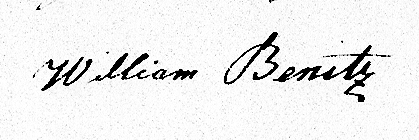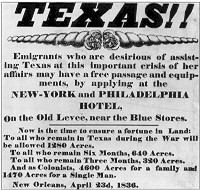 |
William Benitz | Page last modified: |
 |
William Benitz | Page last modified: |

The first to investigate William’s Texas history was his son Alfred A. Benitz when visiting the US in 1904. Alfred’s diary entry for October 18, 1904:
I left in the morning for College Station, where I was very kindly received by Dr. Marshall, Dr. Francis the 'boss vet' being away. I had mess with the teachers. The following day Dr. Rizin innoculated a calf against 'Texas Fever' to show me how it is done, and also gave me a pamphlet explaining everything. I left before noon and went back to Bryan station, where they were having a county fair, and there I saw a roping contest. I then went on to Austin where I stopped two nights. I went through the State Capital and also through the records to see if Father’s name was there, but could not find it. They told me there had been a fire about the year 1855, which had burned a lot of records. I then went to see a lawyer, a Mr. Morrow, promised to write to me if he could find out anything.
Why Alfred thought his father had been in Texas is not apparent from his diary. Nor do we know if Mr. Morrow found anything.
Census data provides snapshots of the population. However, no full census was taken in Texas or California during that period; Texas was a struggling newly independent republic (see below), California was part of Mexico. The first US census to include them was taken in 1850 by which time William was well established in California.
More recently (2000), we queried the Texas Ranger Hall of Fame and Museum. Dan Agler (Curatorial Technician) replied to say William had not been a Texas Ranger.
Undaunted, René Anderson Benitz (our intrepid web-slave) continued searching. She discovered amongst the records of early Texas history at the Texas State Library, available to the public on microfilm (now online), the following entry for William Benitz. It identifies a document signed by William, a claim for land owed upon a voucher issued by the government of the Republic of Texas. This is the first recorded proof we have that shows he was in Texas.


Summary: The claim shows William served as a private in Company II, first Regiment Permanent Volunteers of the army of the Republic of Texas, 1 October, 1836, through 29 August, 1837, and was honorably discharged by the Surgeon General. For military services rendered, he was paid partly in cash and the rest in the form of a "bounty", a voucher for land (1,708 acres/687 hectares) - the Republic of Texas had little hard cash, but plenty of empty land. Many servicemen sold their vouchers; this record shows William sold his to a J.J. Clayton, signed William Benitz.
At the foot of this page we provide:

William’s land claim (#3245) consists of a transfer of title and supporting documents proving a William Bennett served in the army of the Republic of Texas. The claim was probably presented by the buyer (J.J. Clayton). It was filed in the name of William Bennett because all the supporting military records (pay-chits, discharge papers, etc.) have his name down as William Bennett or William Bennetts. However he signed his name as William Benitz, clearly legible on the transfer of title to J.J. Clayton (see here and below, frame #601). The handwriting of the signature matches exactly that of a list of William’s children, written by him thirty years later. The samples of his hand-writing shown here are taken from a photo of that list.

|

|

|
When transcribing this document, we maintained its spelling and punctuation, with the following exceptions: (i) words that were written above crossed out text we show as underlined text, and (ii) J.J. could be J.S.
For value received I transfer all my right title and interest which I have to seventeen hundred and eight acres of land coming to me for military services rendered as set forth in
mythe within Certificate of Discharge toArchibald Littleto J.J. Clayton his heirs or assigns, and do by there presance authorize and impower the said J.J. ClaytonArchibald Littleto select locate survey and perfect title to said land in his own name or in my name if required by law at his own expence and according to law this power and transfer is irrevocable from and after datedone at the City of Houston the 27th day of
October 1837 (J.J. Clayton x?x?x?x?x)
In presence of
signature witness#1 William Benitz (signed)
signature witness#2
signature witness#3
War Department
Houston Aug 29th ??7To all whom it may concern
Know Ye - That the bearer William Bennetts a private in Company (I) first Regiment Permanent Volunteers, who enlisted the service on the first day of October 1836, to serve for during the War, is by Surgeon General [Astefuale?] of disability to perform military duty Honorably discharged from the Service.
Banarar Bue (signature)
Pd to 31st May 1837 Sec" of War
War Department
Houston Aug 11 1837I hereby certify that the bearer William Bennetts a private of Company II 1st Regt Pmnt Volunteers, & is entitled to pay from the first day of June up to the thirty
firstday of July 1837 & that he has received his pay after the thirty first day of May 1837( signed )
Acting Sec of War
3111
$16
William Bennett
filed 11 August 1837
examined same
admitted to audit
for $16
Military
MB Golding C Clertz (signatures)
and act auditor
1 June 1837
to 11 August 1837
No draft 4025 As
Approved 12 Aug 1837
Elle Pease (signature) controler
3245
$28
William Bennett
filed 30 August 1837
examined same
admitted to audit
for $23-74
Military
Mr B Goldings lde (signature)
and act auditor
1 June 1837 1837
to 30 August 1837
No draft 4188 As
Approved 30 Aug 1837
EusHeasa (signature) controller
Auditor’s Office
Houston, 11 August 1837
This day came William Bennett and says the annexed instrument is just, true and original, and the only one that he has offered for liquidation: that he owes the government nothing on his account, or on account of any other person.
Sworn to before
Mr BGirdamga (signature) Auditor
Auditor’s Office
Houston, 30 August 1837
This day came William Bennett and says the annexed instrument is just, true and original, and the only one that he has offered for liquidation: that he owes the government nothing on his account, or on account of any other person.
Sworn to before
Mr BGirdamga (signature) Auditor
If in October 1836 William enlisted in the army of the Republic of Texas under the name William Bennett, then it is possible he served earlier that same year under the same name in the Texas militias. Listed as a participant at the battle of San Jacinto (21 April, 1836) is Bennett, Wm., member of a company commanded by Captain Thomas H. McIntire of the 2nd Regiment Texas Volunteers, in turn commanded by Colonel Sidney Sherman.
However, the possibility is low that William Benitz was the William Bennett present at the Battle of San Jacinto. Here is why:
In about 1817 the U.S.A. abandoned its claims for Texas in exchange for Spanish concessions in Florida. However, Anglos continued to settle in Texas. In 1821 it became a state in the new Mexican Empire. By 1822 the settlers were clashing with the new government. By 1835 the Anglo population in Texas was 35,000, ten times the number of Mexicans. They formed their own local legislature and agitated for representation in the Mexican government. Instead its president, General Santa Ana, dissolved his own legislature (and of the states, including Coahuila y Tejas) and declared himself dictator. Several states rebelled, including Texas.

In June, 1835, Santa Ana sent troops north which were driven out by the Texians, beginning the Texas War of Independence. In October, 1835, the Texians captured Goliad and San Antonio. Santa Ana took the Alamo in a bloody massacre in March, 1836, which led to his (also bloody) defeat by General Sam Houston at San Jacinto in April, 1836.
Texas declared independence from Mexico on 2 March, 1836, and was a republic for ten years until February, 1846, when it joined the U.S. as a state. Sam Houston was inaugurated as its first president 22 October, 1836, and its congress organized national and local governments along U.S. lines. The new republic, ravaged by war, its treasury empty, paid many of its debts with land.
Texas State Library and Archives Commission
The following excerpts were taken (and some adapted) from the Texas State Library web site:
www.tsl.state.tx.us/arc/repclaims/repintro.html
The Republic Claims series of Comptroller’s records includes claims for payment, reimbursement, or restitution submitted by citizens to the Republic of Texas government from 1835 through 1846. It also includes records relating to Republic pensions and claims against the Republic submitted as public debt claims after 1846. The files include supporting documents such as vouchers, financial accounts, military records, receipts, notes, or letters. ....
The records comprise four groups of payments made for services rendered during the period 1835- 1846: Audited Claims, Republic Pensions, Public Debt Claims, and Unpaid Claims.
The Republic Claims are made up of papers submitted to the Texas Comptroller or Treasurer to document or to verify goods or services provided to the government of the Republic of Texas in order to receive payment. Records in the claims include the following: ...
c. Documentation for military service or association with any military engagement during the period October 1835 through 1845.
Once a person’s right to receive a payment for goods or services provided the government during the Republic period (1835-1846) was established by the Comptroller or the Treasurer, a voucher would be issued. The payment could be made to:
a. The person who performed the service or provided the goods
b. That person’s assignee-someone designated by the original claimant to receive the payment instead of himself. (Because the Republic government was usually broke, claimants would frequently sell their vouchers at a lower rate to a buyer who could supply immediate cash.)
The Republic Claims are divided into four series: Audited Claims, Public Debt Claims, Republic Pensions, and Unpaid and Miscellaneous Claims.
Claims that were submitted to the Comptroller or Treasurer of the Republic, that were audited and approved (or allowed) and paid by that government during the Republic Period are considered Audited Claims. The series includes both civil and military claims. The services and the payments for these services date between 1835 and 1846.
© Peter Benitz (Benitz Family)